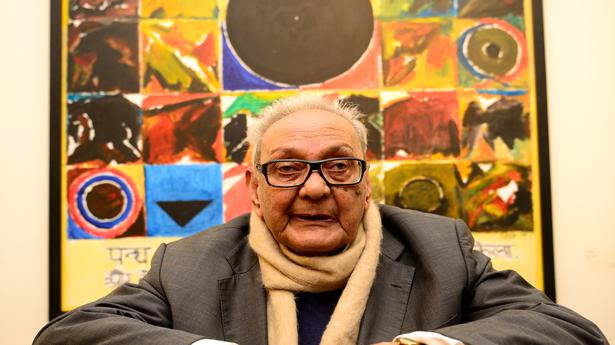
‘Raza was secular, with a global outlook’
The Hindu
Curator Ashvin Rajagopalan, who is writing a book on SH Raza’s Bombay years, on why this generation can’t afford to forget the artist
It’s funny that I’ve never met the man I’m obsessed with. The only time I saw SH Raza was for a couple of minutes in 2015, a year before he died, at the India Art Fair, when he dropped by to see our curation of Krishen Khanna’s work. He came in, I took a photo, and he left. It was like an ‘if I had run into a celebrity’ moment.
I believe we cannot forget Raza because his contribution to modern Indian art is being fully understood only now. He had a 73-year-long career, from 1943 (when he officially started to call himself an artist working in Bombay) to 2016. And in that time, among the many things he’s taught us, are two important points.
First, his secularism. He came to Bombay a year after the Quit India movement launched in the city. Raza saw both the protest and the result, which is very rare. (We often have to wait decades to see the result of our protests.) Raza was involved with all the key players — with Mulk Raj Anand and the progressive writers, and Ebrahim Alkazi and the progressive theatre group. He was at the forefront of artistic protest. But through it all, he maintained his secular outlook. He is the ultimate example of what India can do.
Second, his global aesthetic. Art in India — other than indigenous forms like miniatures, Tanjore paintings, kalamkari, etc — is western academic art. The idea of the canvas, oil paints, exhibitions, galleries, everything is western. In that context, Raza realised he was learning modern art second hand, and he wanted to go to the primary source. So he went to Paris and in 1956, won the Prix de la Critique — a critics’ award, which is a high honour, much like the BAFTAs (and not the Oscars). He was the first non-French person to get it.
Raza constantly pursued a global understanding of modern art. He opened a gateway and created a continuous dialogue between people in India and Europe. This is a lesson young artists today should learn. You may paint something that resonated with you in your village, but how will I explain it to a collector in Mumbai, Iran or London? You should learn to expand your ability to communicate beyond your own little bubble. That’s why a Picasso resonates with the world. Or a Raza. They speak a global language. You don’t need to explain circles and squares and tantra and bindu.
In the Louvre in Abu Dhabi, there is a Mark Rothko hanging immediately next to a Raza. It says that here are two artists who dealt with very similar concepts, and anybody in the world can understand them.
Passion project

A. Kanyakumari’s online programme ‘Ekaika Raga Kritis of Tyagaraja’ turns into a live concert series
A. Kanyakumari launched the ‘Ekaika Raga Kritis of Tyagaraja’ series with a concert

 Run 3 Space | Play Space Running Game
Run 3 Space | Play Space Running Game Traffic Jam 3D | Online Racing Game
Traffic Jam 3D | Online Racing Game Duck Hunt | Play Old Classic Game
Duck Hunt | Play Old Classic Game










